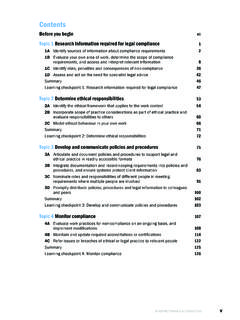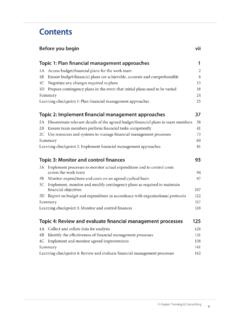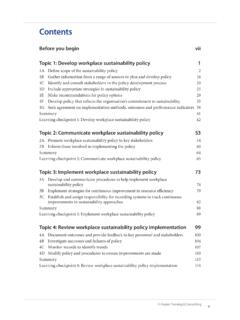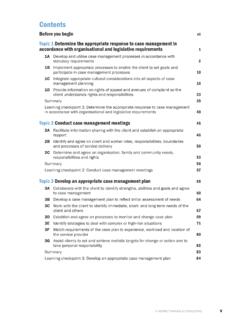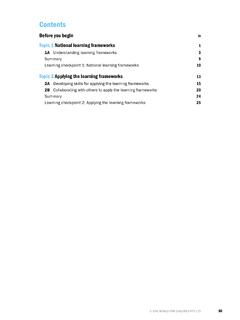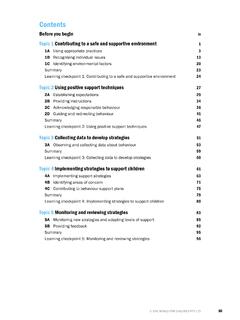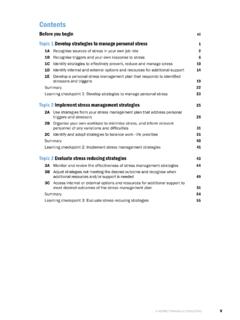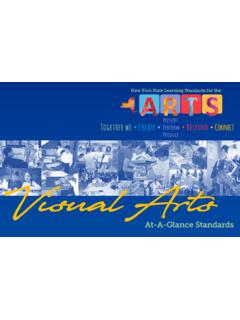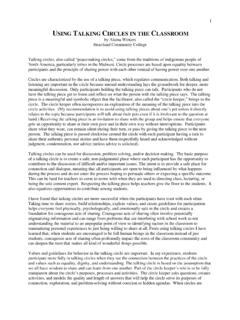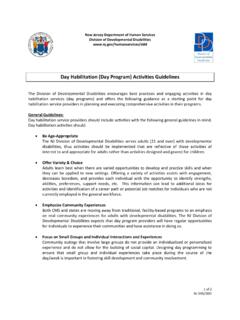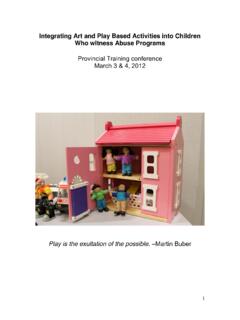Transcription of CHCECE019 Nurture creativity in children, Release 3
1 ONE WORLD FOR CHILDREN PTY LTD iiiContentsBefore you begin ivTopic 1 Fostering creativity in the physical environment 11A Promoting creative expression 31B Providing a range of materials to encourage creativity 11 Summary 19 Learning checkpoint 1: Fostering creativity in the physical environment 20 Topic 2 Fostering creativity in the human environment 232A Encouraging children to pursue their own ideas and appreciate others work 252B Showing enthusiasm for creativity 332C Supporting children to be responsible for equipment and materials 36 Summary 38 Learning checkpoint 2: Fostering creativity in the human environment 39 Topic 3 Fostering creativity through a learning framework 433A Teaching children techniques when using materials and equipment 453B Planning and creating opportunities for children to collaborate creatively 483C Involving children in critical reflection and problem-solving 503D Displaying children s work in a meaningful way 533E Allowing time for creativity and responding to children s interests 55 Summary 58 Learning checkpoint 3: Fostering creativity through a learning framework 59 Topic 4 Providing experiences to develop children s skills and creativity 634A Providing a creative environment 654B Providing experiences to develop children s skills 72 Summary 92 Learning checkpoint 4.
2 Providing experiences to develop children s skills and creativity 93 Topic 5 Evaluating experiences 975A Using a range of methods to evaluate children s learning 995B Reflecting on evaluations and making changes to stimulate creativity 104 Summary 105 Learning checkpoint 5: Evaluating experiences 106 ONE WORLD FOR CHILDREN PTY LTD 1 Fostering creativity in the physical environmentBy developing an awareness of expressive development in children, you can plan and provide age-appropriate experiences to support their individual creative tend to express themselves in more creative ways if you plan, set up and provide experiences that are open-ended, fun and 1In this topic you will learn about:1A Promoting creative expression 1B Providing a range of materials to encourage creativity8 CHCECE018 Nurture creativity IN CHILDRENS ensory awarenessVisual, auditory, body kinaesthetic (for example, how to move and shape their body) and tactile experiences (for example, running with bare feet or swirling a scarf)ExplorationTesting physical abilities, choosing movements they are capable of achieving and choosing movements that are new and challengingProblem-solvingSolving problems such as:XXCan I fit through this hoop?
3 XXHow can I balance this ball?XXHow can I reach that? XXHow can I use this scarf in dance? XXHow can I move fast and slow? XXHow do I use this equipment?Imagination and creativityFreedom to explore their body movements and abilities, expressing thoughts and feelings, and interpreting actions in their own waySocial skillsWorking in groups, communication, self-direction, self-awareness, and recognising and appreciating their own and others uniquenessExampleExpressing creativityCallie wants to introduce the children in her group to a range of different movement ideas . She accesses some posters of people involved in different cultural dances and a range of music that she can play to displays the posters and plays the music, talking to the children about which poster might link with this music. The children offer their ideas about the music, then talk about why each dance might be important to the people in the this, Callie asks if dance is important to any of the children.
4 Some talk about how they have lessons, and others talk about how they dance at special then gives the children an opportunity to dance to the music in ways they feel the music tells them to Children have individual ways of expressing their feelings. Drama is an excellent method for doing this. By respecting this and encouraging children to be open in communication and play, children will express themselves in various ways. Their expression depends on factors such as:XXthe environment in which they are raisedXXthe opportunities given to themXXemotional support and developmentXXtheir ageXXlimits and boundaries set by families and educators XXthe materials and resources provided to them. ONE WORLD FOR CHILDREN PTY LTD ONE WORLD FOR CHILDREN PTY LTD 11 TOPic 1 FOS TERING creativity IN THE PHYSICAL ENVIRONMENT1B Providing a range of materials toencourage creativityCreativity can be encouraged through the physical environment (materials and resources provided) and the human environment (the social and interactive component).
5 The environment needs to appeal to children to provoke their creativity . It needs to empower young children to explore, be curious, investigate, aspire, develop relationships with others and dream of what could and present beautiful spaces, open-ended resources, many choices, natural resources and attractive children to use a range of materialsIf you present experiences in an interesting way, you encourage children to participate. Children are likely to explore more freely as their curiosity takes over and they take the opportunity to choose how to play. You can encourage this by:XXproviding an environment that is visually stimulating and attractiveXXsetting up creative experiences and displays, including selecting and presenting a range of props and accessoriesXXdisplaying children s own creative work along with adult displaysXXmodelling your own appreciation of beauty and creativityXXusing creativity and representation to record aspects of the programXXconsidering the use and appealing nature of the indoor and outdoor up for creative learningWhen setting up an environment, you need to think about how it will encourage creativity .
6 Tips for encouraging creativity :XXSeparate noisy areas from quiet ones; for example, place block corners away from easels, and use shelves, dividers and furniture to separate materials and equipment at the children s level on open shelves where they can see and access them, and choose what they would like to experiences and activities logically in the room; for example, place water play activities in the wet area outside, and climbing or gross motor activities on carpeted tables, chairs and other areas to cater for the number of children you want at the activity, and ensure seats are at the correct height so that children are up activities according to the space that is available; ensure there are enough activities for the children, but do not overcrowd the there is enough space for the child to spread out materials, move to create their desired work and use their level of ONE WORLD FOR CHILDREN PTY LTDCHCECE018 Nurture creativity IN CHILDRENThe focus should be on using muscles and discovering how things feel.
7 Toddlers enjoy sensory and messy play experiences, such as play dough, clay, slime and finger painting. They need some guidance in art activities, as they will often experiment on walls, doors and other surfaces. This generally occurs because they are unaware of the rules of drawing and wish to explore the toddlers are able to begin to experiment with scissors and glue. These children require supervision as they learn to use these tools play for preschoolersPreschoolers have greater muscle control than toddlers. They enjoy the same creative materials, but are able to use them in more complex ways. By four or five years of age, some children are able to draw recognisable objects, although many details may be missing. By six years old, most children are interested in discussing their a wider range of colours and a variety of materials and ways to use them. Always allow children of this age to explore new materials in a simple experience before offering them in a more complex way.
8 Ask children what materials they want to use, as they are now able to make choices and play for school-age childrenSchool-age children are able to use their imaginations competently. They have their own ideas of what they think is creative and visually stimulating. School-age children have also developed their own interests and can independently make their own decisions in materials and resources are used in a more constructive manner and older children are able to use their imaginations to visualise the type of product or artwork they would like to create. They have longer concentration spans than younger children, which allows them to sit and complete an activity of interest to them. They also have good muscle control, allowing them to experiment with a range of materials, resources and selecting materials for creative play, consider developmental safety and the level of learning, as outlined in the following stageAppropriate materials and activitiesInfantXXA selection of toys valued for their textures, colours and sizesXXLarge toys that cannot be swallowedXXToys that have no sharp edgesXXToys that are easily washed and cleanedXXDifferent types of experiences.
9 For example, water play, sand play and outdoor playToddlerXXIndoor and outdoor activities running together or at different times of the dayXXActivities that reflect an interest in the world and a desire to explore it with the different sensesXXExperiences that reflect mastery of the child s own body ONE WORLD FOR CHILDREN PTY LTD 23 Topic 2In this topic you will learn about:2A Encouraging children to pursue their own ideas and appreciate others work2B Showing enthusiasm for creativity 2c Supporting children to be responsible for equipment and materialsFostering creativity in the human environmentChildren learn to express their feelings and thoughts through self-expression and social interactions. They find out that everyone has their own ideas , feelings and encouraging children to foster their creativity , educators help children develop as individuals, reflect on their abilities and respect other people s efforts. ONE WORLD FOR CHILDREN PTY LTD 27 TOPic 2 FOS TERING creativity IN THE HUMAN ENVIRONMENTE ncouraging original ideasWhen children come up with their own ideas for an activity they are usually more committed to it as it will relate to their interests at the children come up with their own ideas , interpretations and expressions spontaneously; at other times, you may help spark these ideas .
10 Use your oral communication skills to encourage children and give them to encourage children to pursue their ideas :XXAllow them to do whatever they feel like with the materials and situation you children sufficient time to work out their ideas . Never hurry them; let them know they can leave their work and come back to it t judge their efforts, as this is likely to stifle their them to think of new ideas by prompting them or asking them safety is always a children to work through their own ideas while providing support, encouragement and the required resources. You may need to assist children to work out what they need and how they will use materials. However, you should stand back to allow them to develop their own play and think carefully about what they are doing. This helps children to develop a range of skills, including:XXproblem-solvingXXpersistence XXpeer scaffoldingXXsharing thoughts, knowledge and information with othersXXpositive emotional and social creative is not just about letting children run with an idea; they still need supervision and direction to ensure they are safe.
